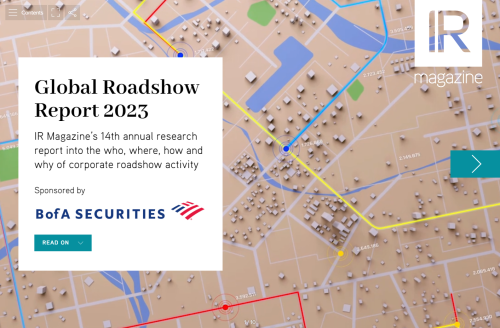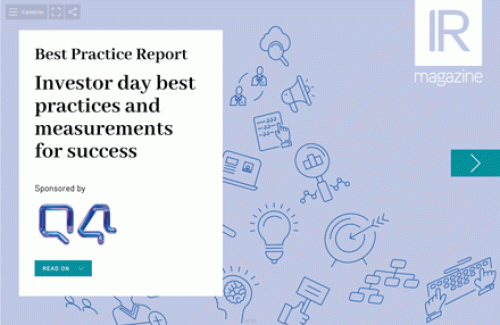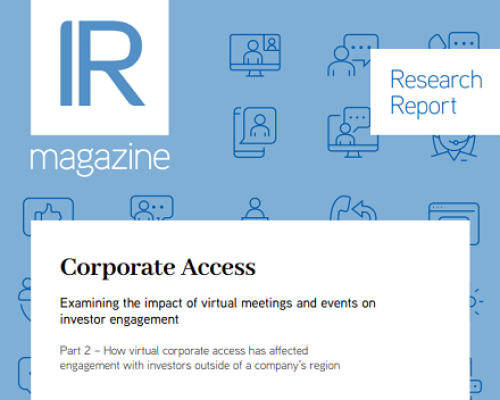IR teams are taking advantage of the flexibility offered by virtual outreach to broaden their investor targeting and include a more diverse mix of executives in meetings with the buy side.
Despite the lack of constraints, however, geography remains a key consideration in how companies approach their IR activities, with most sticking to roadshows focused on a particular city or region.
Overall, there has been a downtick in meeting activity year on year between companies and investors, says Christopher Blake, corporate advisory director at IHS Markit.
When lockdowns first came in and in-person meetings were cancelled, some IR teams weren’t ready to move all of their activity to virtual, he explains. For example, some companies went ahead with maintenance meetings and conference appearances, but pushed back non-deal roadshow planning.
‘As we moved further into the situation, it became clearer that the virtual environment was not going anywhere,’ says Blake. ‘We’ve now seen an uptick in teams thinking about planning a virtual non-deal roadshow and trying to more fully embrace the virtual environment.’
Increased flexibility
Blake says the flexibility of virtual outreach has allowed some companies to be more selective in the meetings they take at conferences. ‘On both sides, for the IR team and the investor, you’re really only logging into these calls if you both want to be there,’ he explains.
Speaking on an IR Magazine webinar in mid-June, Lowell Singer, senior vice president of IR at The Walt Disney Company, said it’s now easier to meet with investors who might not be willing to travel.
‘First of all, I think it benefits the buy side because you have a lot of portfolio managers [who], rather than spending two days flying to California to meet with a few companies including Disney, which they prefer not to do, are happy to get on a 45-minute call to talk with us,’ he said.
‘I also think it’s more efficient for our management team: it’s much easier to get our CFO or CEO to do 10 of these [calls] over the course of a six-month period than fly to New York four separate times or fly to Boston or Europe.’
While there are downsides to virtual outreach, such as the more challenging nature of building personal relationships, overall it does create a more efficient way to get in front of investors, said Lowell.
During the same webinar, Lynn Antipas Tyson, executive director of IR at Ford Motor Company, said the use of virtual meetings has allowed her to include a broader range of Ford executives in conversations with investors.
‘Being able to prep somebody and get a really focused subject matter expert to speak on a topic and be able to do it virtually is a luxury,’ she said. ‘For example, we have several very important product reveals coming up over the next several months and if I was going to go to a conference, I might bring a higher-level person, but I’m going to use the actual engineers who designed the vehicles… so it can be a more in-depth conversation.’
Geographic focus
IHS Markit ran a poll asking companies how important geography is in the Covid-19 environment for roadshow activities, such as targeting and selecting brokers. Around two thirds of respondents say geography has become less important, but a significant minority (32 percent) say geography is as important or more important than before.
‘Historically, a non-deal roadshow was a very geography-centric type of event,’ says Blake. ‘Now we’ve heard some situations where you might tell a bank you want to do a non-deal roadshow and, as it’s virtual, there’s nothing to stop you from opening that event up geographically to anybody the bank might be able to put you in touch with.
‘It’s a double-edged sword, though, because as you’re looking to work with different banks to plan these events, you open yourself up to more overlap in those meetings if you’re not constraining each event to a specific area.’
While companies are now less constrained by location, Blake says many are continuing to think about roadshows through a geographical lens. One reason for that is simply companies defaulting to their normal approach of targeting certain cities or regions.
Furthermore, IR teams are aware that in-person meetings will come back. They need to consider whether their activity during the Covid-19 pandemic will be sustainable over the long term. ‘Are we comfortable continuing that relationship virtually? Or are we locking ourselves into, one day down the road, needing to travel to that area?’ says Blake.
Narrowing the options
Cembra Money Bank, the Zurich-based financial services company, says it has broadly stuck with a geographical approach to roadshows. If you didn’t have a geographical focus, it would become too complicated to decide who could and couldn’t join, explains Marcus Händel, head of IR and sustainability.
He says, however, that the company has been more flexible about who is allowed to join meetings. For example, on a recent virtual roadshow to New York, Cembra widened availability for calls to investors based in the surrounding region.
Cembra has also recently returned to physical roadshows. While flights are still out of the question, the IR team took a one-hour car drive to Basel to meet investors. ‘They said they would be very happy to see us personally again,’ says Händel. ‘And likewise, we also thought it would be nice to see people.’
The bank met with investors including pension funds and private banks, although there were no handshakes and all parties followed social distancing rules. ‘It's possible to do one-on-one meetings if the company rules are okay for that on both sides,’ says Händel, noting that smaller investment firms are more open to meetings at the current time than larger ones.
The virtual nature of corporate access offers investors the chance to throw their net wider, too. IHS Markit analyzed its buy-side data to find out which investment firms undertook the most international meetings with companies during May. The list contains many of the world’s largest institutional investors, but also a significant number of hedge funds.
‘It was surprising to me that in this environment, where [hedge funds] weren’t able to go to conferences and sit down with a significant number of issuers in group meetings, they were still able to interact virtually with a large number of clients,’ says Christopher Stroh, situational analytics director at IHS Markit.










